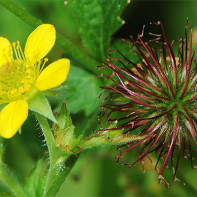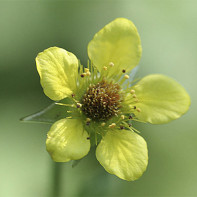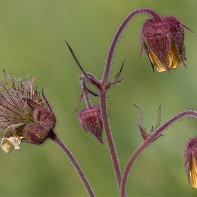Gravilate: medicinal properties and contraindications
Gravilate on the planet is found everywhere - perhaps, except for Antarctica. This plant from the family of pink fell in love with landscape designers and gardeners. They treat many diseases of various profiles. Women use it to bring beauty and culinary creations to the table, prepared with the addition of this pleasant, clove-smelling plant. In addition, sometimes rhizome is used as a tannin for the skin and as a dye for fabrics, giving them golden and brown tones. The people came up with a lot of names for him. Perhaps the most memorable of them - clove potion, clove spirit and clove root, living grass, grass cleaner, lover, love grass, dogs.
- Chemical composition
- How it looks and where it grows
- Views
- Collection and storage
- The healing properties of gravilate
- Gravilate in folk medicine
- From corns
- With a cold
- Cleanser
- Children with rickets
- For digestive diseases
- With kidney disease
- With bronchitis
- Hemostatic agent
- Gastritis
- Types of healing compounds
- Infusion
- Tincture
- Decoction
- Application in cosmetology
- Mask for oily skin
- Body bath
- From skin rashes
- From eczema and skin irritations
- From swelling on the face and spider veins
- Contraindications
Chemical composition
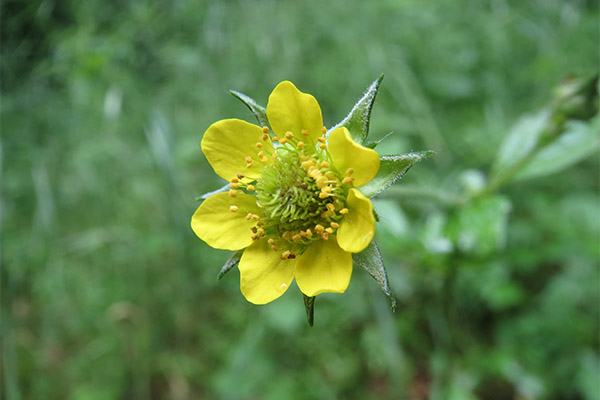
- The yellow coloring pigment and tannins are contained in the rhizomes of the plant, and there are many tannic ingredients - about 40% of the chemical composition.
- In addition to these components, the plant has flavonoids, known for their strengthening effect on the walls of blood vessels. They provide their elasticity and reduce permeability.
- Contained in the plant and a large set of carbohydrates. In combination with other useful substances - minerals, vitamins, flavonoids and flavones - they are able to suppress the action of free radicals, inhibit the processes of tissue oxidation and, accordingly, delay both external and internal aging of the body. At its core, these substances are real natural antioxidants. Of the vitamins, a high content of carotene and ascorbic acid in the leaves should be noted, which determines the immunostimulating effect of the plant.
- Bitter substances, as well as components of the essential oil, work in friendly conjunction with antioxidants - they stimulate and control the metabolism in the body. By the way, essential oil is contained in the rhizome in an amount of 0.4%. It seems to be a little, but it gives the plant a fairly stable pleasant clove smell. Gravilate essential oil is specially extracted by steam distillation, it is reddish in color. It is even used in the pharmaceutical industry for the aromatization of drugs.
- Organic acids of gravilate, playing a significant role in maintaining the acid-base balance of the body, contribute to the improvement of all the functions of the digestive system, the removal of toxins and the maintenance of human health in general.
- There are quite a lot of tannins in the plant, its contents are different in different parts of the gravilate. But overall it reaches 30%. These substances are known and widely applicable in medicine and pharmacy, because they have a number of beneficial effects - such as hemostatic, anti-inflammatory, antimicrobial, antiseptic and antimalarial.
- The source of energy for the body are polysaccharides and starch, also found in the plant.
- There is a glycoside gein in the gravel. Like all substances of the glycoside group, it can be considered both from the negative side and from the positive. In case of an overdose, they are poisonous, but when used wisely, they stimulate appetite and stimulate the digestive tract, have a locally irritating effect, regulate the activity of the heart muscles and normalize the vascular system, and also actively fight against pathogenic microorganisms.
How it looks and where it grows
This perennial herb reaches a height of 30 to 60 cm.It has a rather thick rhizome, from which a root leaf rosette comes out. It consists of strongly toothed leaves attached to long petioles. The stem is straight, faceted, branching. There are few leaves on it, they are divided into three pointed sectors, with denticles along the edge. They are attached to the stem with so short petioles that they seem sedentary. Leaves vary in size - basal larger than stalked. The entire green part of the plant is slightly covered with soft pubescence - small hairs.
Flowers are located on the tops of each branch of the stem, their pedicels are short and also covered with soft white hairs. Each flower is five-petalled, they are wide open, along the edge they have a small indentation, similar to a softly carved heart. The most common natural color of the flowers of gravilate is yellow, less often white or pink can also be found. They are collected in inflorescences from 3 to 10 pieces each. Inflorescences are different - both having the shape of an umbrella, and similar to a panicle.
Gravity blooms from late spring to early summer. After flowering, fruits called multi-roots appear, in each of them there are many seeds with a tail curved at the end. Seeds ripen in early September.
Gravilate is not particularly demanding on the soil, raw and acidified soils just do not fit it. Most often, this plant is found on forest edges, and is widespread everywhere - from Europe, Asia and Africa to Australia and both Americas. He does not care about the heat of the tropics or semi-deserts, nor the frosty Russian winters. The only continent where there is no gravity is Antarctica.
Views
In nature, there are about fifty varieties of gravilate, 20 of them are cultivated. In Russia, you can find 11 species - both in the natural environment and cultivated.
- Mountain Gravilate. Its usual place of growth is the mountainous regions of Europe. This species is bushy, but not high - no more than 30 cm, its leaves are rough to the touch. The flower does not fully open and therefore has the shape of a cup. Blossom begins in June. The flowers are bright yellow in color, rather large - up to 4 cm across. He loves the sun, can’t stand the shadow, tolerates cold weather quite steadily.
- Gravilate is creeping. Creeping gravilate is in many ways similar to its mountain relative and grows in the neighborhood - in the Alps, Balkans, Carpathians. The plant is low - only 15 cm. Single golden-colored flowers begin to delight from the beginning of summer. It is often used to design flower beds.
- Gravilate city. It features a very thick rhizome, for which it is appreciated by traditional healers. It grows in all countries, in Russia it is most common in the Urals. One of the highest species is up to 70 cm. The flowers are small - about 1.5 cm, have a yellow, but rather light color, if not to say that it is faded. It blooms from May and then forms a lot of seeds, which germinate quite easily, as a result, the gravilate spreads rapidly, displacing all other herbs.
- Gravilate tame. A typical resident of the American continent, but also found in Eurasia. One of the few types of gravilate that can live on abundantly moist soil, including along the banks of rivers and lakes. The rhizome is powerful, the height corresponds to its power - up to 70 cm. It differs in the brown color of the stem. Flowers have an interesting color - yellow with a red or red-brown strip, have the shape of a bowl.
- Gravilate of Aleppo. Despite the high growth - 70 cm, has a short rhizome. He has an external resemblance to urban gravilat, but Aleppo is more pubescent, even, one might say, fluffy. His element is birch forests, their edges, steppe meadows. Widely distributed throughout Russia - from the European part to the Far East, Central Asia and the North American continent. Self-seeding with the help of wind easily spreads over decent distances and large areas. To limit its distribution, timely mowing is required - before the seeds ripen.
- Chilean Gravilate. His homeland is Chile, hence the name.Tall and bushy plant, covered with a thick fluff. It is characterized by large - about 4 cm - terry flowers of purple color, blooms quite a long time - from the end of May until the end of summer.
- Gravilate is bright red. The birthplace of this type of gravilate is the Caucasus and the territory of the Balkan Peninsula. On the basis of a plant emerging from these areas, breeders have produced a very beautiful flower, which is appreciated by landscape designers and gardeners. A tall bushy plant with large bright red flowers, collected in a hat of 2-4 pieces. It blooms from May to the end of summer.
- Large-leaved gravilate. From the name it is clear that a characteristic feature of this species is larger in comparison with other types of foliage. Each leaf is wide, has the shape of an egg. But the flowers are smaller, paler and plainer than that of related plants - only 1 cm in diameter. Flowering begins in May and ends in mid-summer. The homeland of this species is North America.
- Gravilate ross. This variety is noteworthy because it is distributed mainly in cold climates - in the Arctic regions of the North American continent. It is perfectly preserved and normally hibernates in such harsh conditions.
- Gravilate triflorum. A short perennial, grows no higher than 30 cm. It is successfully used for decoration of flower beds and beds, it is widely used not only in private, but also in urban landscape design. Bright yellow flowers deliver aesthetic pleasure with their cheerfulness. Among the bright yellow colors, orange can also appear.
- Hybrid Gravilate. Breeders have bred many varieties of this variety of gravilate. Basically, they differ in large inflorescences of orange and red hues. Among the most popular are such varieties as pale orange Gladys Perry and Princess Juliana and orange-red Fire Opal.
Collection and storage
Since there is practically no land not suitable for growing for gravilate, it can be found both on urban natural lawns and along roads. Such plants cannot be taken and harvested for medicinal purposes, since they absorb all harmful substances from industrial emissions and car exhausts. It is better to go for workpieces out of town, in forests and meadows.
The green part of the plant, as well as the flowers, must be collected when it begins to bloom, cutting off the gravilate with a sickle almost at the very base of the stem. It is better to go to the blanks in the morning, but not too early: it is necessary for the dew to have time to dry.
You can dry the whole greens or separate the flowers and make a separate blank. They have the same drying conditions. First, the medicinal raw materials need to be slightly dried in the shade, in the fresh air, and the dried plant should be brought to readiness in an electric dryer, setting the temperature to 45-50 degrees. To make it easier to put the plant in the dryer, it is better to cut it into pieces beforehand.
It is better to put finished medicinal raw materials in paper bags, cardboard boxes or cotton bags in which they are stored in a dry room for no more than a year.
Rhizomes should be prepared in the fall, by this time they have time to accumulate the largest amount of healing substances. For medicinal purposes, adult plants are most suitable. The dug out roots need to be shaken off the soil, washed thoroughly with a brush and, like the green part, first dried in the air and only then sent to an electric dryer or oven, where the temperature is set to 45 degrees. Under such conditions, the drug perfectly preserves both beneficial substances and the characteristic distinctive smell of gravilate - the smell of cloves.
Store healing rhizomes in cotton bags in a dry room, under these conditions they are suitable for use for three years.
The healing properties of gravilate
Gravilate is a plant known as medicinal in ancient Greece. It was the Greeks who described him in medical treatises. And it was recognized as the official medicine of our country in 1818 and entered into the Russian Pharmacopoeia.
Thanks to the substances that make up the medicinal plant, the preparations prepared from it possess anti-inflammatory, wound healing, antiseptic, astringent, antimalarial, diaphoretic and general strengthening effects. Its compositions are able to relieve abdominal pain caused by spasms, eliminate stagnation of bile, reduce fatigue and add vitality, and reduce perspiration.
Aqueous compounds - infusions and decoctions - and alcohol tinctures are prepared from a medicinal plant, they use gravilate directly - just grinding it to a powder state. The list of diseases that the plant copes with includes colitis of various origins, catarrh of the stomach, intestinal colic and increased gas formation, vomiting and dysentery. Gravilate and respiratory system doctors - from simple cough to whooping cough, pneumonia, bronchial asthma and even tuberculosis. Jade and cystitis, cholecystitis and liver problems, neurosis and C-vitamin deficiency - for the treatment of all these diseases there is a recipe based on a healing plant.
Gravilate is also used to solve male and female delicate problems: relieve impotence, taken as a means to stimulate uterine contraction and stop bleeding - moreover, not only uterine, but also hemorrhoidal.
The antiseptic and anti-inflammatory abilities of the medicinal plant are also in demand for external use in the treatment of tonsillitis, periodontal disease, gingivitis and stomatitis - moreover, for very complex and neglected cases, when necrotic tissue changes are already observed, to accelerate wound healing. Gravilate expels worms and fights against rickets, is effective as an antiviral, diaphoretic, antimalarial and tonic.
Gravilate in folk medicine
According to a centuries-old tradition, traditional medicine uses a medicinal plant to get rid of a wide range of problems - from ordinary sweating to serious ones, such as tumors.
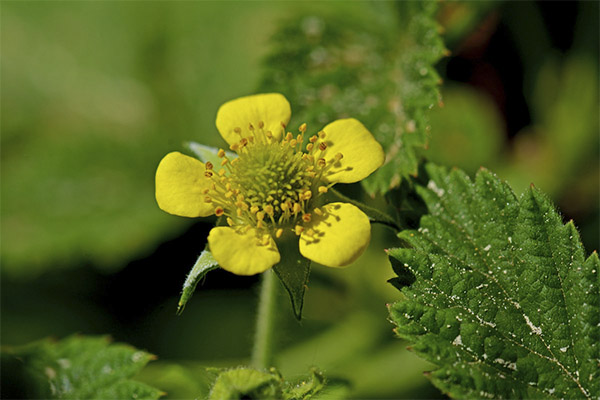
From corns
To get rid of dry corns, you will need a fresh, just dug out rhizome of gravilate. It must be cut in half lengthwise and bandaged with a cut to the corn overnight. Repeat the procedure daily until the corn disappears.
With a cold
To make a drink that alleviates the condition for colds, you need to take 15–20 grams of powder prepared from any aerial parts of the plant — leaves, stems, flowers — pour boiling water over it and wait 3 hours until it is infused. After straining, drink 2 sips in the morning and evening. The drink will not only help to recover more quickly from a cold, bronchitis or sore throat, but also strengthen the immune system and become an excellent preventive measure against subsequent diseases.
Cleanser
Such a composition is prepared only from dried leaves of the plant. Rub them with your fingers to the state of the powder and take 2 teaspoons of the medicinal raw material. Pour 2.5 cups of boiled water, warm for 20 minutes in a water bath. If you drink a tablespoon of this composition per day, the balance of trace elements in the body will be restored - such as iron, sodium and magnesium. It also cleanses blood vessels and helps heal complex wounds.
Children with rickets
Baths with this composition are prescribed for babies older than six months.
Gravilate is used as a component of grass collection, in which this plant is mixed in equal proportions with chamomile, nettle and a string. You need to take 4 tablespoons of the composition and boil 15 minutes in water (3 liters). After straining, add to the bath water (20 liters). The duration of the water treatment is 10 minutes.
For digestive diseases
Liver diseases, cholecystitis and gastritis can be treated with a composition prepared from the root and grass of gravilate, 10 grams of which are ground and boiled for 10 minutes in 250 ml of water and pour the mixture into a thermos for 2 hours. Then filter and drink the liquid during the day, dividing into 4 doses.
With kidney disease
Take 250 grams of dry grass in 250 ml of water and cook the composition for half an hour. As it cools down, strain and take 3 times a day before sitting at the table, a tablespoon of the broth.They can also gargle with angina and mouth with stomatitis.
With bronchitis
To alleviate cough with bronchial asthma and bronchitis, it is recommended to take powder from the dried root of gravilate before meals. Take the product on the tip of a teaspoon, seize it with honey and drink it with water.
Hemostatic agent
- With uterine or hemorrhoidal bleeding for 30 minutes, boil 2 tablespoons of the shabby root of the healing plant in half a liter of water. After cooling, strain and drink the resulting liquid throughout the day in small doses.
- In serious cases, a more saturated broth is needed, which is prepared from 30-40 grams of root and one and a half glasses of water. It must be evaporated over low heat half, strain and take every hour a tablespoon.
Gastritis
A medicinal herbal preparation is being prepared from gravilate, plantain, hemophilus and thyme, taken in a tablespoon. Also to it you need to add 3 tablespoons of meadowsweet, chamomile, flax, mother and stepmother, Ivan tea, lemon balm and 2 tablespoons of hop and heather cones. This volume will be enough for the whole course of treatment, because for a daily intake, a composition of only 1 tablespoon of the mixture, filled in a thermos of 300 ml of freshly boiled water, is prepared. Use after 6 hours of aging and straining. Divide the liquid into three servings and drink each half an hour before meals.
Types of healing compounds
The main dosage forms in which traditional medicine uses a healing plant are infusion, tincture, and decoction.

Infusion
- Infusion of grass. This medicinal plant calms nerves well. To prepare the infusion, pour a tablespoon of crushed leaves with a glass of boiled water and insist for at least two hours, strain and drink the resulting liquid during the day, divided by two.
- Infusion of roots - 1 option. To heal a sick liver, relieve spasms of the gallbladder and intestinal colic, folk healers help infusion from the roots of gravilate. Scalp the cut roots (tablespoon) with a glass of boiled water and keep under a tightly closed lid and a warm towel for at least two hours, preferably even three. Three-hour infusion can be replaced by steaming in a water bath for half an hour. After cooling, strain the composition and take up to 4 times a day - before meals, drinking 2-3 tablespoons at a time.
- Infusion of roots - 2 option. With flatulence, diarrhea, vomiting, intestinal colic and even dysentery, an infusion of 2 teaspoons of finely chopped, just dug up medicinal plant root, filled with 250 ml of boiled water, is shown. After two hours of infusion in a tightly sealed container, strain the product, divide into two equal portions and drink it in the morning and evening half an hour before meals.
Tincture
- Tonic tincture. In 100 ml of vodka, pour a tablespoon of finely chopped fresh root of the plant and leave for a month in a dark place. Strain and drink 10-15 drops, diluting them in 100 ml of water, before breakfast, lunch and dinner. It has a calming effect and is recommended for the treatment of nervous disorders, as well as gives vitality.
- Tincture for stomach cancer. In half a liter of vodka, soak 5 large spoons of the root of the medicinal plant, pre-ground. Until ready to insist 2 weeks. The treatment with this tincture as a part of complex therapy is indicated for patients suffering from gastric cancer. The norm of admission is from 20 to 30 drops three times a day one hour after eating. In some cases, healers appoint a teaspoon of the drug for a single dose.
- Tincture on the wine. Half a liter of wine requires 5 teaspoons of crushed roots of a medicinal plant. Infusion time is a week. The strained composition can be used to establish the process of digesting food, reducing gas formation and stopping vomiting.Drink 50-60 minutes after eating (3-4 times a day) in a tablespoon.
Decoction
- For half an hour, boil 15 grams of fresh raw roots in 200 ml of water. After cooling, filter. With this broth gargle with angina, as well as apply lotions to relieve joint pain with dislocations and rheumatism.
- With a weak boil, hold on a fire for 10 minutes a glass of water with a teaspoon of shabby fresh rhizome of gravilate. Then insist for another hour, after which strain and drink throughout the day, from time to time making a sip. A broth is prescribed to stop uterine bleeding.
- On a small fire for 10-15 minutes, boil 250 ml of water with 2 teaspoons of freshly chopped root of a medicinal plant, then leave for 2 hours for infusion. This broth is good to gargle with laryngitis or tonsillitis. The composition also helps to treat the oral cavity with gingivitis, stomatitis and other problems of the mucous membranes. Rinse 4–5 times daily until the symptoms disappear completely.
- In a glass of hot water, stir a tablespoon of fresh, cut into small pieces of the root of the plant and send for 20 minutes to a quiet fire, then remove and insist for another 50-60 minutes. Filter and drink a tablespoon 20 minutes before eating 3 to 4 times a day. It is recommended for the treatment of dry cough with bronchitis.
Application in cosmetology
Essential oil obtained from gravilate is actively used by perfumery and cosmetics companies. It gives the product a pleasant clove aroma, and thanks to the antiseptic ability of the plant, preparations are made from it, which have a cleansing, analgesic and light drying effect on the skin.
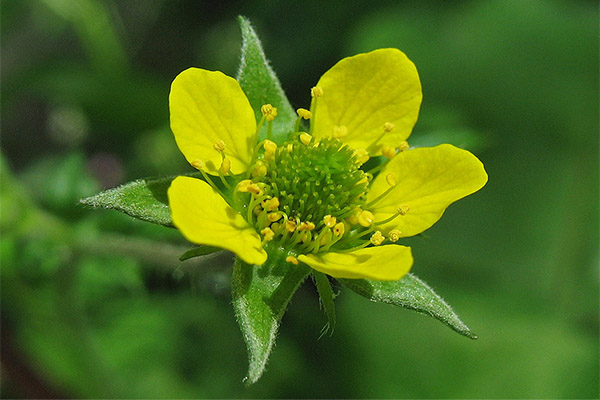
In home cosmetology, gravilate is mainly used for oily skin. With the help of a healing plant, you can reduce the amount of sebum, tidy the dermis and regulate sweating.
Mask for oily skin
Boil a teaspoon of gravilate greens for half an hour in half a liter of water. Remove the composition from the stove, strain it hot and gently, in a small stream, with constant stirring, add 2 tablespoons of starch to the liquid. Cool the resulting mass for a quarter of an hour and apply to the face for 30 minutes. These half an hour do not do any business, relax and watch your favorite good TV show.
Body bath
To improve the condition of oily skin, cleanse the pores or reduce the appearance of acne, which often appears on the back with oily skin, it is necessary to prepare a decoction of 8 tablespoons of the plant (any parts of gravilate are suitable) and a liter of water. Boil the mixture for a quarter of an hour, pour into a thermos and hold in it for a couple of hours, then filter the broth and pour it into the bath - and you can immerse yourself in water, enjoy and be treated at the same time.
From skin rashes
Grind the dried rhizome of the medicinal plant in a coffee grinder to a powder state. Take 2 large tablespoons of the powder and mix it with a tablespoon of pork fat, which is preferably slightly heated. Lubricate redness, rashes of acne type in the mornings and evenings.
From eczema and skin irritations
On the skin of the hands affected by eczema, apply the leaves of the plant, for greater effect, pre-stretch them so that the juice appears. Fix medicinal herb with dry clean bandages. Repeat the procedure once a day until the skin is in order. This tool will also help to get rid of other skin diseases.
From swelling on the face and spider veins
The usual norm of an ordinary day cream is mixed with the pulp obtained with a blender from fresh leaves of gravilate. Put a creamy-herbal composition on the face and lie down for 20–25 minutes, then rinse off the rest of the grass with warm water. The therapeutic effect is achieved due to the strengthening effect of the plant on the walls of blood vessels, increasing their elasticity.If this procedure is carried out regularly, edema will not appear, and spider veins will disappear with time.
Contraindications
The peculiarity of gravilate is that it predisposes to blood coagulability, therefore it is not recommended for patients prone to blood clots, suffering from thrombophlebitis. Those who have low blood pressure also need to give up trying to be treated with this medicinal plant.
Due to the presence of astringent and tannin ingredients in its composition, gravilate is forbidden to those who are familiar with chronic constipation. Pregnant women, nursing mothers and children are also contraindicated gravilate.
And, like every medicinal plant, gravilate probably has components on which someone will have an individual intolerance. Such people can’t use it.
«Important: all information on the site is provided exclusively in fact-finding purposes. Before applying any recommendations, consult with a profile specialist. Neither the editors nor the authors are liable for any possible harm caused materials. "

